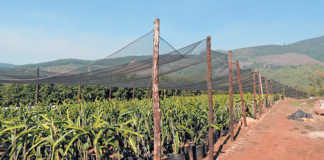Test-tube calf embryos are more likely to survive hot summers than embryos developed with artificial insemination, using frozen sperm.Research shows that heat-stressed dairy cows suffer damage to their ovarian follicles and the eggs ovulated for the next 40 or 50 days, according to Texas AgriLife Extension Service dairy specialist Todd Bilby.Todd and graduate student Brandi Stewart have found a way to double the pregnancy rate in the summer and increase the number of heifers born compared to conventional artificial insemination.
Todd says there’s only a 50% chance that a lactating dairy cow will actually conceive in summer, and even then, the heat stress on a developing embryo may cause it to die in the first three days of development. When a cow doesn’t become pregnant, the dairy operator not only loses a calf, but the cow won’t lactate, so valuable milk production is lost. And it’s expensive to feed and care for a non-productive cow until the next time she can fall pregnant, so the operator often has to cull her.
In-vitro versus in-vivo
Modern dairies rely mostly on artificial insemination (in-vivo), using frozen sperm, to get cows pregnant as they come into heat. But since the late 1980s, an embryo-transfer system (in-vitro or test-tube) has been used. During in-vitro fertilisation, the egg is fertilised in the lab under climate-controlled conditions, so the resulting embryo isn’t subject to the heat-stress-induced mortality rate of an in-vivo embryo, Todd says.
The in-vitro embryo is transferred to the recipient cow after seven days. However, it was expensive to produce viable embryos by stimulating cows to super-ovulate – producing many eggs at one time – with hormones. Luckily, there’s now an alternative.Eggs can be harvested from slaughterhouse cows, then fertilised in the lab with semen from high-quality bulls. Several hundred eggs can be fertilised at a time at a greatly reduced cost compared to super-ovulation methods.
Research findings
In their research, Todd and Brandi used 722 cows from participating central Texas dairies in the summer of 2009. The study compared fresh and frozen embryos that had been fertilised with sex-sorted semen, which is gender-biased towards more female sperm, and incubated for seven days before being transferred to the mother cow.They split the cows into three groups. The first was artificially inseminated with traditional methods. The second received frozen embryo implants. The third received fresh embryo implants.
All cows were oestrus-synchronised using standard methods. The artificial insemination group was inseminated using either timed schemes or following detected oestrus. The other two groups had embryo transfers seven days after completion of the oestrus-synchronisation protocol.
In the 40 to 47 days after the transfers, all cows were pregnancy-tested. Of those receiving fresh embryos, 42% were pregnant, while only 29% of those receiving frozen embryos were pregnant. The artificial insemination group had the lowest pregnancy rate of 18%.
Cows were pregnancy-tested again at 90 to 104 days after treatment. There was an overall drop in pregnancy rate, but those receiving fresh embryos still had the highest pregnancy rate at over 36%, compared to the frozen-embryo group at 28% and the artificially inseminated group at 17%.“Using in-vitro produced embryos with sex-sorted semen can bypass the damaging effects of heat stress on fertility while increasing the number of heifer pregnancies,” Todd says.
“This could be a viable option for producers to maintain fertility in summer months.”He says using fresh or frozen embryos paired with sex-sorted semen, instead of artificially inseminating, increased the number of calves born and the percentage of heifers. With frozen embryos, 80% of calves born were heifers and with fresh embryos it was 88%, compared to the 50% using artificial insemination.













